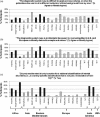Psychologists' perspectives on the diagnostic classification of mental disorders: results from the WHO-IUPsyS Global Survey
- PMID: 23750927
- PMCID: PMC3725658
- DOI: 10.1080/00207594.2013.804189
Psychologists' perspectives on the diagnostic classification of mental disorders: results from the WHO-IUPsyS Global Survey
Abstract
This study examined psychologists' views and practices regarding diagnostic classification systems for mental and behavioral disorders so as to inform the development of the ICD-11 by the World Health Organization (WHO). WHO and the International Union of Psychological Science (IUPsyS) conducted a multilingual survey of 2155 psychologists from 23 countries, recruited through their national psychological associations. Sixty percent of global psychologists routinely used a formal classification system, with ICD-10 used most frequently by 51% and DSM-IV by 44%. Psychologists viewed informing treatment decisions and facilitating communication as the most important purposes of classification, and preferred flexible diagnostic guidelines to strict criteria. Clinicians favorably evaluated most diagnostic categories, but identified a number of problematic diagnoses. Substantial percentages reported problems with crosscultural applicability and cultural bias, especially among psychologists outside the USA and Europe. Findings underscore the priority of clinical utility and professional and cultural differences in international psychology. Implications for ICD-11 development and dissemination are discussed.
Cette étude porte sur les points de vue et les pratiques des psychologues en matière de systèmes de classification diagnostique des troubles mentaux et du comportement, afin d'aider à l'élaboration de la CIM-11 par l'Organisation mondiale de la santé (OMS). L'OMS et l'Union internationale des sciences psychologiques (IUPsyS) ont effectué une enquête multilingue de 2 155 psychologues de 23 pays recrutés par le biais de leurs associations de psychologie nationales. Soixante pour cent des psychologues du monde utilisent systématiquement un système de classification officiel, avec la CIM-10 utilisée le plus fréquemment par 51 % d'entre eux et le DSM-IV, par 44 %. Les psychologues considèrent que les plus importants objectifs de la classification sont de prendre des décisions de traitement éclairées et de faciliter la communication. Et, aussi, ils préfèrent des orientations diagnostiques flexibles à des critères stricts. Les cliniciens évaluent favorablement la plupart des catégories diagnostiques, mais identifient un certain nombre de diagnostics problématiques. Un pourcentage substantiel d'entre eux ont signalé des problèmes avec l'applicabilité transculturelle et les biais culturels. C'est surtout le cas avec les psychologues qui ne sont ni américains ni européens. Les résultats soulignent la priorité de l'utilité clinique et les différences culturelles et professionnelles en psychologie internationale. Les auteurs discutent des implications pour le développement de la CIM-11 et de sa diffusion.
Este estudio examina el punto de vista como también las prácticas de los psicólogos respecto de los sistemas de clasificación de diagnóstico para los trastornos mentales y conductuales, con el fin de informar el desarrollo del ICD-11 hecho por la Organización Mundial de la Salud (OMS). La OMS y la International Union of Psychological Science (IUPsyS) realizaron una encuesta multilingüística entre 2155 psicólogos provenientes de 23 países, reclutados a través de las asociaciones nacionales de psicólogos. El sesenta por ciento de los psicólogos utilizaba de rutina un sistema formal de clasificación, siendo el ICD-10 el sistema utilizado con mayor frecuencia (51 por ciento) y el DSM-IV utilizado el 44 por ciento. Según los psicólogos, el propósito más importante de la clasificación era para decidir sobre diferentes tratamientos, como también facilitar la comunicación, y preferían parámetros flexibles de diagnóstico en contraste con criterios estrictos. Los clínicos evaluaron de manera favorable a la mayor cantidad de categorías de diagnóstico, pero identificaron un número de diagnósticos problemáticos. Hubo un porcentaje substancial que dijo tener problemas con la aplicación transcultural y el sesgo cultural, especialmente entre los psicólogos fuera de los Estados Unidos y Europa. Los hallazgos enfatizan la prioridad de la utilidad clínica y las diferencias profesionales y culturales en la psicología internacional. Se analizan las implicaciones para el desarrollo y la difusión del ICD-11.
Figures








References
-
- American Psychiatric Association. Diagnostic and statistical manual of mental disorders. 4th ed. text rev.) Washington, DC: APA; 2000.
-
- American Psychiatric Association. DSM-5 Development. 2013. Retrieved from www.dsm5.org.
-
- Bell C. C., Sowers W., Thompson K. S. American Association of Community Psychiatrists’ views on general features of DSM-IV. Psychiatric Services. 2008;59:687–689. - PubMed
-
- Cohen J. Statistical power and analysis for the behavioral sciences. 2nd ed. Hillsdale, NJ: Lawrence Erlbaum Associates; 1988.
-
- First M. B. Clinical utility: A prerequisite for the adoption of a dimensional approach in DSM. Journal of Abnormal Psychology. 2005;114:560–564. - PubMed
MeSH terms
LinkOut - more resources
Full Text Sources
Other Literature Sources
Medical

